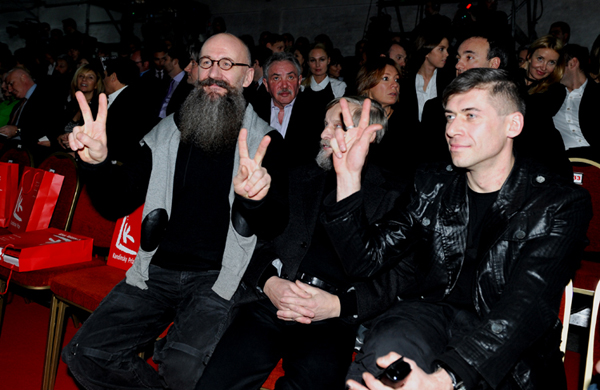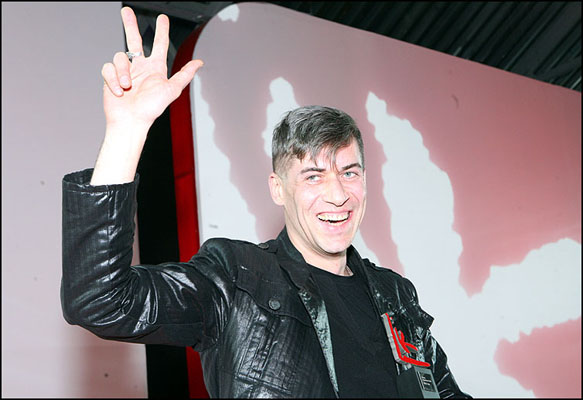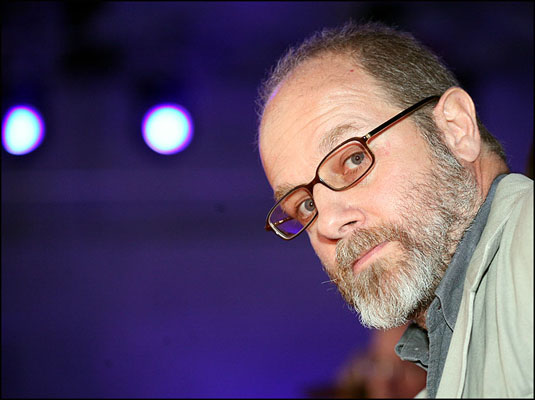A Fascist in Our Midst: Alexey Belayev-Guintovt and the Kandinsky Prize Scandal
 The few hundred practitioners and enthusiasts of Contemporary Russian art like to think of it as a collective activity. With talk of “our art, our artists, our pavilion in Venice,” the myopic and occasionally Lilliputian Moscow scene exhibits unusual solidarity when it comes to fighting for a place under the sun. But last December, when amid cries of “Disgrace!” and accusations of fascism, ultranationalist painter Alexey Belyaev-Guintovt beat out Sots Art legend Boris Orlov and Marxist Dmitry Gutov to win the 2008 Kandinsky Prize, a deep, bitter division broke ranks from within, and the word “them” added itself to the equation.
The few hundred practitioners and enthusiasts of Contemporary Russian art like to think of it as a collective activity. With talk of “our art, our artists, our pavilion in Venice,” the myopic and occasionally Lilliputian Moscow scene exhibits unusual solidarity when it comes to fighting for a place under the sun. But last December, when amid cries of “Disgrace!” and accusations of fascism, ultranationalist painter Alexey Belyaev-Guintovt beat out Sots Art legend Boris Orlov and Marxist Dmitry Gutov to win the 2008 Kandinsky Prize, a deep, bitter division broke ranks from within, and the word “them” added itself to the equation.
 Rumblings of a scandal began after Belyaev’s surprise nomination a month before, after critic Ekaterina Degot led a discussion entitled “Could an ultra-right nationalist win the Kandinsky Prize?” While she worried Belyaev would donate the €40,000 prize to “some fascist party,” Moscow State University professor Andrei Kovalev claimed “the ruling class’s fascizoid tendency has become clear – it’s all a lot like Germany in 1933,” and prize jury member Andrei Erofeev suggested, “they should give him the Leni Riefenshtal prize.”
Rumblings of a scandal began after Belyaev’s surprise nomination a month before, after critic Ekaterina Degot led a discussion entitled “Could an ultra-right nationalist win the Kandinsky Prize?” While she worried Belyaev would donate the €40,000 prize to “some fascist party,” Moscow State University professor Andrei Kovalev claimed “the ruling class’s fascizoid tendency has become clear – it’s all a lot like Germany in 1933,” and prize jury member Andrei Erofeev suggested, “they should give him the Leni Riefenshtal prize.”
 Belyaev, whose website divides its links page into “Us and Them,” is the official stylist for the Eurasianist Movement of Youth, a bizarre, somewhat incoherent and quasi-mystical following based around the notorious philosopher Alexandr Dugin, who was at the center of the last “fascism” scandal in Russian art a decade before when Neoacademist leader Timur Novikov began to associate with him. Since then, Eurasianism has largely abandoned its calls for “fascism as limitless as our lands, and red as our blood” in favor of a broadly pro-Putin stance, but Belyaev himself still calls for a “union with our great Eastern neighbors” and portrays this nationalism entirely unironically in his work. The prize-winning paintings, Brothers and Sisters and Daughterland, come from a longer series of the latter name in which Belyaev combines Stalinist imagery with traditional Russian motifs and a very heavy dose of gold leaf to create a stark, grandiose vision of a future where homogenous Eurasian supermen march across Red Square.
Belyaev, whose website divides its links page into “Us and Them,” is the official stylist for the Eurasianist Movement of Youth, a bizarre, somewhat incoherent and quasi-mystical following based around the notorious philosopher Alexandr Dugin, who was at the center of the last “fascism” scandal in Russian art a decade before when Neoacademist leader Timur Novikov began to associate with him. Since then, Eurasianism has largely abandoned its calls for “fascism as limitless as our lands, and red as our blood” in favor of a broadly pro-Putin stance, but Belyaev himself still calls for a “union with our great Eastern neighbors” and portrays this nationalism entirely unironically in his work. The prize-winning paintings, Brothers and Sisters and Daughterland, come from a longer series of the latter name in which Belyaev combines Stalinist imagery with traditional Russian motifs and a very heavy dose of gold leaf to create a stark, grandiose vision of a future where homogenous Eurasian supermen march across Red Square.
 By the time of the awards ceremony, the vitriol had become so overblown as to turn the ceremony into a referendum on Belyaev’s political views, and his victory seemed to be the logical conclusion for an evening that began with a picket against him. Belyaev took to the stage to a bizarre mixture of rapt cheering, mild applause, and stunned silence and managed to get all of one sentence out before tension gave way to bedlam. The 2007 winner Anatoly Osmolovsky leapt to his feet, screaming “Disgrace! Disgrace!”; nominee Dmitry Gutov refused to include his work in the planned prize exhibitions in Kiev and London; and the Moscow art world wandered awayshaken, confused, and wondering what will happen next.
By the time of the awards ceremony, the vitriol had become so overblown as to turn the ceremony into a referendum on Belyaev’s political views, and his victory seemed to be the logical conclusion for an evening that began with a picket against him. Belyaev took to the stage to a bizarre mixture of rapt cheering, mild applause, and stunned silence and managed to get all of one sentence out before tension gave way to bedlam. The 2007 winner Anatoly Osmolovsky leapt to his feet, screaming “Disgrace! Disgrace!”; nominee Dmitry Gutov refused to include his work in the planned prize exhibitions in Kiev and London; and the Moscow art world wandered awayshaken, confused, and wondering what will happen next.
Wild accusations flew in the aftermath amid the myriad of conspiracy theories aiming to explain the jury’s 4-3 vote. Particularly outlandish was Osmolovsky’s claim that Belyaev’s Russian supporters on the jury – the St. Petersburg New Museum’s Alexandr Borovsky and historian of the Russian avant-garde Ekaterina Bobrinskaya – were Eurasianist sympathizers. Others posited that Deutsche Bank representative Friederich Hutte and Guggenheim curator Valerie Higgins were too ignorant of the Russian context and the political consequences of their vote to make a fully informed decision, a fact which, given Degot’s earlier confrontation with Higgins over those very same issues of context and consequences at Art Basel Miami Beach the week before seems equally unlikely. Still others cast suspicion on the Triumph Gallery, which represents Belyaev, and Shalva Breus, the organizer of the prize and publisher of ArtChronika, allegedly having struck a murky backroom deal somehow to do with the latter’s reliance on the former’s advertising.
Breus took strong offense to the latter theory, but otherwise kept a far more level head. Despite his vote for Orlov, a number of Orlov’s works contained in his private collection, and his ready admission that Orlov is his favorite artist, Breus explained, “[a]t first I didn’t understand the jury’s choice, but it makes a lot more sense if you look at it from the contemporary angle. We all agreed Orlov’s work was the best, but you can’t say so readily that he’s a contemporary artist.” Indeed, Orlov’s place in the canon is already all but assured – his nomination was in fact for his retrospective at the Moscow Museum of Modern Art. “With Belyaev, on the other hand,” Breus continued, “there’s no doubt.”
Doubt, however, clouds the intentions of former Pompidou director and Orlov supporter Jean-Hubert Martin, who awarded Belyaev 9 out of 10 at the initial stage of judging, missed the second round due to illness, and after the ceremony complained, “I don’t understand how works as uninteresting and lacking any innovation as these could win a prize like this.” For his part, Erofeev had not only exhibited Belyaev previously in Paris but had given him the same score for the same works at the same stage before his public volte-face.
Degot described the prize’s “contemporary” criteria as the “logic of the supermarket” whereby all is at the whim of “consumer demand.” In that sense, Belyaev was already doing rather well: Daughterland all but sold out immediately after its premiere in March at the profit-obsessed Triumph. Amid reports that Belyaev’s prices have risen a further 30% since his victory, Triumph’s co-director Emeliyan Zakharov crowed, “When I ran into her after the scandal started I told her, “Thank you, Katya! You’ve just handed Lesha Belyaev-Guintovt his first prize!”
Although Zakharov went on to posit that Degot deserved a four-year libel conviction for a later radio interview in which she claimed Belyaev made a Nazi salute from the stage, he ultimately exuded satisfaction from his place in the winners’ circle. “It’s like in the Krylov fable. I’m the big elephant walking down the street, and Katya Degot? She’s the little dog running yapping alongside, trying to keep up.”
The blatant disregard for basic etiquette shown by leading professionals such as Degot – in the absence of any photographs, video evidence, or supporting accounts hers is difficult to take seriously as anything except an allegory – or Erofeev gives credit to Belyaev’s analysis of the reaction as fueled by fear. Indeed, the liberal artistic intelligentsia’s virulent reaction seems to be less of an aesthetic or even a political one than just sheer horror at having their turf swept from under them. Belyaev raised no eyebrows as a follower of Novikov in the 1990s, when the latter was daubed with the other F-word and theformer showed with Regina and XL. Those galleries are two of the four pillars of “Us,” the turbulent, unforgiving wasteland of a decade with no infrastructure, no art market, and no money that Russia’s critics still bear like a scar. Triumph is “Them”, the nouveau-riche offspring of Putin’s gilded age that stormed the art market with, depending on whom you ask, some much-needed money or a flood of glossy, surface-heavy and meaningless art.
Bobrinskaya saliently noted that the only criticism anyone has made of Belyaev’s work on artistic grounds is for his use of gold, which seems to raise ire less for his aestheticization of Eurasianist ideals (“black gold” is Russian oil, “red gold” is Russian blood, you get the idea) than for making his works tacky by their mere presence. And if there’s any long-running battle to be traced from the Kandinsky affair, it seems less to do with the influence of Novikov, the association with Dugin, or indeed the art itself, than with the glamur of the jet-setting oligarch class to which the liberals have ceded power.
Six months later, the name Alexey Belyaev-Guintovt has become just another battle scar, a source of pride covered under the critic’s sleeve but sore as hell if ever touched, and best forgotten. But the skirmishes in the war with glamur continue. Bile flew once again in March over an exhibition of Tanatos Banionis, an anonymous group under the “curation” of Triumph co-director Dmitry Khankin. The show was unanimously ravaged in the press for its purported militarism, sexism, and glossy baseness, but Zakharov was untroubled. “With these liberal critics it’s just jealousy, pure and simple,” he glowered. “They think a galerist should drive a Volvo, or an Audi – or even take the metro. But I drive a Bentley!”
And Belyaev’s star is still in the ascent. Since then, two earlier works formed the centerpiece of Triumph’s stand at Art Dubai without raising an eyebrow; he is now apparently working on a fifteen-painting series depicting “a Eurasian parade of the future” due to be out next year and a Stalinist restoration of Tskhinvali, because “Stalinist architecture is the emanation of the sun.” The golden dawn over Eurasia – whatever his critics may have to say about it – fans out regardless.




